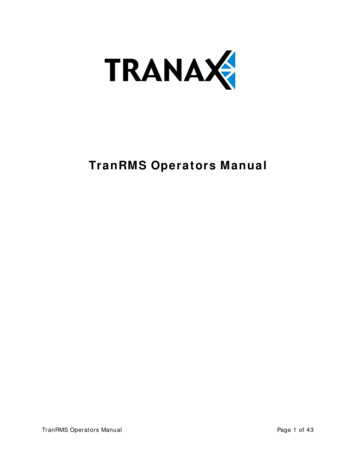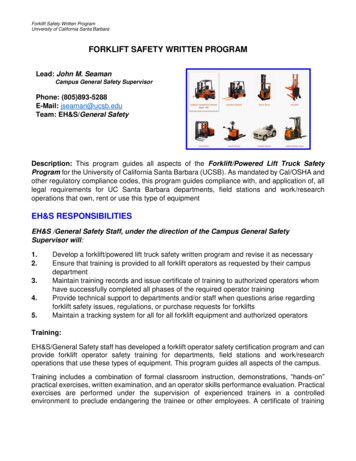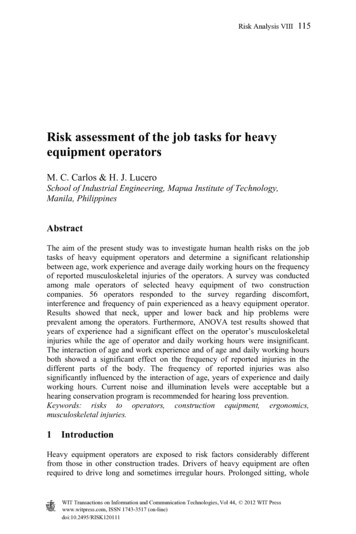
Transcription
Weighbridge Operators Manual:A Guide for Operators who Conduct Public Weighings
Commonwealth of Australia 2008First edition — February 2008Second edition — September 2008Third edition — December 2010Fourth edition — February 2012Fifth edition — January 2013National Measurement InstituteBradfield Road, Lindfield, NSW 2070PO Box 264, Lindfield, NSW 2070TFW(61 2) 8467 3600(61 2) 8467 3610www.measurement.gov.auii
CONTENTSPreface . iv1.Introduction . 12.Terminology . 13.Weighbridge Requirements . 33.1 Approval and Verification . 33.2 Display Sign. 33.3 Location . 33.4 Visibility . 33.5 Approach. 33.6 Platform . 43.7 Pit . 43.8 Electrical and Electronic Devices . 44.Checking a Weighbridge . 44.1 Visual Inspection . 54.2 Zero Operation and Indication . 54.3 Zero Tracking . 54.4 Eccentricity . 54.5 Comparison Check. 75.Weighing Procedure . 76.Weighing Methods . 96.1 Direct Measurement. 96.2 End-and-End Measurement . 96.3 Axle Load Measurement. 107.Measurement Tickets . 107.1 General Requirements and Guidelines . 107.2 Electronically Generated Measurement Tickets . 117.3 Direct Measurement Tickets . 127.4 End-and-End Measurement Tickets . 127.5 Axle Measurement Tickets . 138.Law Enforcement . 138.1 Offences and Penalties . 138.2 Trade Measurement Inspectors . 139.Frequently Asked Questions . 209.1 Accuracy of Measurements . 209.2 Weighbridges used for Trade. 219.3 Public Weighbridges . 21iii
PREFACEThis manual provides guidance on how to operate weighbridges used for trade (includingpublic weighbridges). It should not be relied upon for legal advice and it does not replace therequirements of the National Measurement Act 1960 and the National Trade MeasurementRegulations 2009. If you are in anyway in doubt of your obligations you should seekindependent legal advice.The significant differences between the fourth and fifth editions of this manual are:it includes changes defined in licensing directives up to PW 12/05 (checkwww.measurement.gov.au/PWlicensees for more recent directives);a table has been added to clause 3.5 that defines allowable deviations for weighbridgeapproaches;worked examples of correctly completed measurement tickets have been added; andclauses related to portable and unattended weighbridges, measurement tickets for nonpublic weighings and law enforcement by road transport authorities have been deleted;The following documents referred to in this manual may be downloaded from here or ourwebsite (www.measurement.gov.au):General Supplementary Certificate of Approval S1/0/A Electronic Indicating and PrintingDevices for Measuring Instruments;General Supplementary Certificate of Approval S1/0B Electronic Indicating, Summing orPrinting Devices which are Interfaced and Auxiliary to an Approved MeasuringInstrument;National Measurement Act 1960 (Cth);National Measurement Regulations 1999 (Cth);National Trade Measurement Regulations 2009 (Cth);General Information for Test Procedures; andNITP 6.1 to 6.4 National Instrument Test Procedures for Non-automatic WeighingInstruments.iv
1.INTRODUCTIONThis manual provides guidance on how tooperate weighbridges used for trade(including public weighbridges) incompliance with the National MeasurementAct and the National Trade MeasurementRegulations.A weighbridge is used for trade when it isused, or made available for others to use, tobuy or sell goods, to determine freight costsor other charges based on weight, or todetermine a tax.A public weighbridge is defined in theNational Measurement Act as aweighbridge that:is open for use by or on behalf of thepublic; andis available for use for a charge.A non-public weighing occurs when theuse of the weighbridge:is subject to a prior contractualarrangement between the controller ofthe weighbridge and person for whomthe weighing is being performed, whichdoes not include a fee per use charge; oris to determine the tare mass of avehicle or trailer for registrationpurposes.Public weighbridge licensees are able tocontract with other businesses to operatethe weighbridge on their behalf.Anyone 18 years or over may apply for alicence either individually or as a companyor a partnership.1/2013To operate a weighbridge effectively anoperator must be able:to adhere to all legislativerequirements;to understand their legal obligationsand duties;to provide an accurate measurement forthe vehicle or goods being weighed;andto issue measurement tickets correctly.An operator should weigh any vehicleduring normal operating hours, unless:the vehicle is too wide or too long to fiton the weighbridge;the operator believes the measurementwould be inaccurate; orpayment is requested up-front but thecustomer refuses to pay.A public weighing occurs when aweighbridge is made available in either ofthe two circumstances stated above,without a prior contractual arrangementbetween the controller of the weighbridgeand the person for whom the weighing isbeing performed.is for the operation of the controller’sbusiness, i.e. to weigh goods in whichthe controller trades; orA licence is not required when:the third party measurements are forweighing ‘vehicles for registrationpurposes’ (specific conditions forissuing measurement tickets apply);weighing ‘stock on the hoof’; orthere is a contractual arrangementbetween the weighbridge owner andthe business using the weighbridge.There are penalties for public weighbridgelicensees and operators who fail to complywith legislative requirements. Seeclause 8.1 for typical offences.Operators must demonstrate they arecompetent. They can do this by completinga recognition kit found atwww.measurement.gov.au/recognitionkit.2. TERMINOLOGYAxle Load MeasurementA measurement, which is not an end-andend measurement, made to determine themass supported by separate axles, or groupsof axles, of a vehicle (see clause 6.3).End-and-End MeasurementWhen a vehicle is too long to fit on theplatform, the weight of a vehicle isdetermined by adding two measurements,one for the front and one for the rear of thevehicle (see clause 6.2).1 of 22Weighbridge Operators Manual v5.0
Indicating DeviceBoth direct and end-and-end measurementtickets can be used to record three differenttypes of measurement information:gross mass only;tare mass only; andnet mass.Part of the measuring device from whichthe direct reading of the result is obtained.InspectorA trade measurement inspector.LicenceNon-public WeighingA licence is either a servicing licence or apublic weighbridge licence.See clause 1.OperatorLicenseeA licensee is the holder of either a servicinglicence or a public weighbridge licence.The person who personally determines themeasurement of a vehicle or goods by useof a weighbridgeLoad-Bearing PointsPlatformThe locations on the deck of a weighbridgedirectly over load cells or knife edges.The part of a weighbridge intended toreceive the load.Load CellPreservation PeriodA load cell is a component of aweighbridge that measures a weight orforce applied to it and sends an electronicsignal to the indicator to display the weight.A weighbridge may incorporate severalload cells.Three years from the date of issue, orcancellation, of a measurement ticket issuedfor a public weighbridge.MassThe difference between the scale valuescorresponding to two successive scalemarks or indications of a digital indicator.The amount of matter of an objectregardless of location (in simple terms the‘weight’):Gross mass is the mass of the vehicleincluding the load.Tare mass is the mass of the vehicleprior to being loaded.Net mass is the result of the subtractionof the tare mass from the gross mass.Maximum Permissible Error (MPE)Maximum difference, positive or negative,allowed by regulation between theindication of an instrument and thecorresponding true value, as determinedusing appropriate reference standards.Measurement TicketMeasurement tickets are issued formeasurements made at publicweighbridges. Includes original and copytickets. There are three types of tickets:direct measurement tickets;end-and-end measurement tickets; andaxle load measurement tickets;1/2013Public WeighingSee clause 1.Scale IntervalVehicleIncludes a vessel, aircraft or any othermeans of conveying persons or goods.Verification MarkAn inspector’s mark (the mark allotted to atrade measurement inspector) or a servicinglicensee’s mark (the mark approved for useby, or on behalf of, a servicing licensee) inverifying measuring instruments.VerifierA person permitted to verify a measuringinstrument, namely a trade measurementinspector, a servicing licensee or anauthorised employee of a servicing licensee.WeighbridgeA measuring instrument of a capacity of3 t or more which has one or moreplatforms capable of determining the massof a vehicle or of livestock.2 of 22Weighbridge Operators Manual v5.0
3.2 Display Sign3. WEIGHBRIDGE REQUIREMENTS3.1 Approval and VerificationWeighbridges used for trade must first bepattern approved, and then tested by averifier in accordance with the requirementsin NITP 6.1 to 6.4 National Instrument TestProcedures for Non-automatic WeighingInstruments to ensure:they measure to within the maximumpermissible errors specified in theNational Trade MeasurementRegulations;they comply with their certificate ofapproval; andthey comply with the requirements ofNational Trade MeasurementRegulations.A verification mark is applied to weighbridges which meet these requirements.Verification marks must contain thefollowing information:the code identification for the verifier(e.g. ABC0123) which is comprised ofthe servicing licensee’ mark (e.g. ABC)or inspector’s mark (NMI) followed bya four digit verifier verification number(e.g. 0123);the month code on which the mark wasmade (A Jan, B Feb etc); andthe year code on which the mark wasmade (0 first year of decade, 9 lastyear of decade).Here is an example of a completed labelbearing a verification mark.INSTRUMENT VERIFIED UNDER THENATIONAL MEASUREMENT ACT 1960ABC0123A0Public weighbridges must be re-verifiedevery 12 months. If a public weighbridgefails re-verification, the verifier will removethe verification mark and advise theoperator the weighbridge may not be usedfor any weighing (public or non-public).Once repaired, the weighbridge must be retested and re-verified before it can be usedfor trade.1/2013At public weighbridges there must be a signdisplayed in a prominent position whichidentifies the weighbridge as a publicweighbridge and includes its publicweighbridge licence number. The sign mustbe easy to read, each letter and numbermust be at least 100 mm high and contrastwith the background colour.3.3 LocationA weighbridge must be located so:a vehicle has enough room to move onand off the weighbridge without havingto turn on any platform;any indicating or visual summingdevice is protected from wind and rain;water, mud or debris does not accumulateon or under a platform; or in the pit; andvehicles must be able to move on andoff the weighbridge without having toreverse.3.4 VisibilityAn operator must have a clear view of eachplatform and the measurement displayed onthe indicator, without moving from theirnormal operating position. The driver of avehicle being weighed should have a clearview of the indicator.3.5 ApproachAn approach to a weighbridge must:have a hard, true and durable surface ofconcrete or another approved material;have the perimeters of the levelapproaches clearly indicated by paintedmarks or other approved means;be arranged so drainage from thesurface of the approach does not flowinto the pit; andbe ‘in the same plane’ as the platformfor a minimum distance of 3 m if theplatform is less than 18 m or 1 m if theplatform is 18 m or more (may need tobe longer for end-and-end and axlemeasurements).The approach is in the same plane as theplatform if:3 of 22Weighbridge Operators Manual v5.0
for weighbridges not used for end-andend weighing, the whole of the surfaceof the approach is within 2 of level(horizontal) measured from the endnext to the platform;for weighbridges used for end-and-endweighing, the approaches are within0.25 of level (horizontal) measuredfrom the end next to the platform.the clearance from the external edgesof the platform must be wide enoughfor servicing, maintenance anddrainage and must be free fromobstructions that may interfere with theoperation or accuracy of theweighbridge; andthe load cell footings must be stable.3.7 PitIf a weighbridge has one or more pits:each pit entrance must be covered;each part of the underwork must befreely accessible; andpits must be kept free from anyaccumulation of water, mud or debris,and be free-draining or be providedwith automatic mechanical drainage.For multi-platform weighbridges, the deadspace (if applicable) between the platformsof the weighbridge shall be level and in thesame plane as each of the platforms.See Table 1 for more information on in thesame plane.3.6 PlatformEach platform of a weighbridge must becomposed of concrete, steel or otherapproved material.3.8 Electrical and Electronic DevicesIf a weighbridge is equipped with electricalor electronic devices they must be protectedfrom electrical and electronic interferenceand the rays of the sun. Also the load celldata plate must be accessible so it may beread with ease.If a weighbridge has more than oneplatform:the dead space between each platformmust not exceed 2 m;each platform must operate in a mannerthat does not affect the operation of anyother platform;the upper surface of a platform shouldbe in the same plane as the uppersurface of each other platform; anda summing indicator must be installed.4.CHECKING A WEIGHBRIDGEThe operator must make sure theweighbridge always operates correctly andadvise the public weighbridge licenseewhenever there is a problem. To achieve this,an operator should:visually inspect the weighbridge at thebeginning of each shift (see clause 4.1);conduct regular checks which mightindicate a problem with weighbridgeaccuracy (see clauses 4.2 to 4.5); andmonitor performance (keep records ofthe tare mass of specific vehicles andreport unexplained variations in mass).Results can be recorded on the checklist.If a weighbridge does not have a pit:the clearance under the lowest live partof the platforms must be at least150 mm;the floor between load cell supportsmust be composed of concrete at least75 mm thick, effectively drained andkept free from any accumulation ofwater, mud or debris;Table 1. Defining level for weighbridge approachesDistance from end ofweighbridge (m)Maximum deviation for 0.25 ( .6Maximum deviation for34.9 69.8 104.8 139.7 174.6 209.5 244.4 279.4 314.3 349.2 2.0 ( mm)1/20134 of 22Weighbridge Operators Manual v5.0
4.2 Zero Operation and IndicationWhen it is suspected a weighbridge willproduce an incorrect measurement,withdraw the weighbridge from use until itis repaired, tested and marked with averification mark (clause 3.1). If it cannotbe repaired the public weighbridge licenseemust inform NMI.Note: Weighbridges should also complywith the relevant requirements inclause 3.The operator must ensure the indicator is atzero or the steelyard is in balance before thevehicle drives onto the platform. Alwayszero/balance the weighbridge in accordancewith the manufacturer’s instructions.The operator should also observe theindicator after the vehicle has left theplatform to ensure it returns to zero/balance.During wet weather it is important to checkthe zero/balance frequently to allow for theaccumulation of water on the platform.4.1 Visual InspectionRefer to the suggested checklist on the nextpage and also check:4.3 Zero TrackingThere is a continuous gap between theplatform and the edge of theweighbridge surround to preventbinding. Stones or other foreign matterjammed between the platform and itssurrounds may cause binding.There is no water, mud or debris on theplatform. Water can accumulate on theplatform due to rain or run-off from avehicle being weighed. Excess watercan affect zero/balance.There is no water, mud or debris underthe weighbridge. Loose loads, such assand, can accumulate in the pit or buildup under the platform and affect zero/balance (see clause 3.7).A weighbridge with zero tracking willautomatically return to zero if the amountleft on the platform does not exceed half ascale interval. This can be up to 10 kg on aweighbridge with 20 kg scale intervals.However if sufficient debris is allowed tobuild up on the platform the weighbridgewill not return to zero/balance and theplatform will need to be cleaned in order forthe weighbridge to return to zero/balance.4.4 EccentricityThe eccentricity check is designed to ensurethe weighbridge weighs the same regardlessof where the load is placed on the platform.To complete this check:Place a forklift (5 to 6 t) in the centre ofthe platform and note the reading.The weighbridge structure is in goodcondition with no lose bolts and nobroken, missing or rusty components.Progressively place the forklift over theload bearing points (knife edges or loadcells) until all load bearing points havebeen tested. Record the indications ineach position. It is good practice toensure there is no more than one scaleinterval variation between all theindications.The weighbridge approaches are ingood condition and the perimeters areclearly marked (see clause 3.5).Any steelyards or dial and weight unitmechanisms are in good workingcondition.Any digital indications are clear and allsegments work.Any additional indicating devices workand repeat the indication exactly.1/2013For example, on a weighbridge with a scaleinterval of 20 kg, a forklift that indicates5 960 kg in the centre of the platform isplaced over the four load bearing points.Indications ranging between 5 940 and5 960 kg or 5 960 and 5 980 kg areconsidered acceptable. However indicationsless than 5 940 or more than 5 980 kg arenot acceptable.5 of 22Weighbridge Operators Manual v5.0
Weighbridge ChecklistWeighbridge location .Operator’s name . Date of check .Visual Inspection (clause 4.1)Is/are the verification mark/s present and current?yes/noIs/are the platform/s free from binding?yes/noIs/are the platform/s free from accumulated water, mud and debris?yes/noIs the pit/space under the weighbridge free from accumulated water, mud and debris?yes/noyes/no/naIs the pit pump operational?Is the weighbridge in good condition?yes/noAre the weighbridge approaches smooth, level and in good condition and are theperimeters clearly marked?yes/noIs any steelyard in good working condition?yes/no/naAre any dial and unit weight mechanisms in good working condition?yes/no/naAre any digital indications clear and are all segments working?yes/no/naDo additional indicating devices work and repeat the indication exactly?yes/no/nayes/noIs the indicator set to zero?Check Results Pass Fail N/AZero tracking check (clause 4.3)Eccentricity check (clause 4.4). Pass Fail N/A.Comparison check A (clause 4.5.1)Difference between measurements of the same mass on Pass Fail N/Atwo different weighbridges. . – . . kg/tComparison check B (clause 4.5.2)Difference between the known mass of a test object and the mass of Pass Fail N/Athe test object indicated by the weighbridge . – . . kg/tComments.1/20136 of 22Weighbridge Operators Manual v5.0
4.5 Comparison Check4.5.1 Comparison Check AUse the direct measurement method (seeclause 6.1) to weigh a load of 50 to 70% ofthe capacity on both your weighbridge andanother verified weighbridge. After makingallowance for the weight of fuel used(10 L of diesel has a weight of about 8.3kg) compare the indications. The differenceshould not exceed two scale intervals.4.5.2 Comparison Check BWeigh a test object and compare theindication with the known mass of the testobject (i.e. the mass determined directlyafter verification). The difference shouldnot exceed one scale interval.Test objects should be:at least one-third the capacity of theweighbridge (although other suitablecapacities may be used); andretained solely as a test object and notbe subject to weight change.Complete the measurement ticket in anapproved form, in numerical order, withappropriate care and as soon as practicableafter making the measurement. For moreinformation see clause 7.To ensure the weighbridge is weighingaccurately at all times, conduct regularaccuracy checks (see clauses 4.2 to 4.5).When it is suspected a weighbridge willproduce an incorrect measurement,withdraw the weighbridge from use until itis repaired, tested and marked with averification markby an authorised verifier (clause 3.1). If itcannot be repaired the public weighbridgelicensee must inform NMI.The following basic procedure is goodpractice for determining the net weight of aload on a vehicle.1.Instruct the driver to approach theweighbridge slowly and to proceeddirectly onto the platform withoutturning or harshly applying brakes.2.Ensure the vehicle is completely on theplatform. Ensure no tyres are rubbingagainst anything because this willproduce inaccurate results.3.Weigh the vehicle using the appropriateweighing method. When the vehicle fits onthe platform you must use directmeasurement (clause 6.1) otherwise useend-and-end measurement (clause 6.2).Unless prohibited for occupationalhealth and safety reasons, ask thedriver and any passengers to get out ofthe vehicle and off the platform. It maynot be the same driver, or thepassengers could be missing, when thevehicle returns. (This is the appropriateprocedure for trade transactionshowever for law enforcement of roadrules the driver may be required to stayin the vehicle.)4.Use axle measurement (clause 6.3) todetermine the load on each axle or axlegroup.Weigh the loaded (or unloaded)vehicle. Record the gross (or tare) masson the measurement ticket as soon asthe weighing is completed.5.Once the vehicle returns, weigh theunloaded (or loaded) vehicle. Ensurethe tare (or gross) mass is included onthe measurement ticket as soon as theweighing is completed.5.WEIGHING PROCEDUREGenerally a weighbridge is used todetermine the weight of goods being carriedor to determine the load on each axle toensure the vehicle is not overloaded beforetravelling on a public road. Fees for the useof a weighbridge are not prescribed bylegislation.At the beginning of each shift visuallyinspect the weighbridge to ensure it is ingood working order (see clause 4.1).Before each measurement, make sure theweighbridge indicates zero (see clause 4.2).Note: End-and-end measurement may onlytake place on weighbridges permittedto conduct such measurements.1/20137 of 22Weighbridge Operators Manual v5.0
6.To obtain the net mass, subtract the taremass from the gross mass. Record thenet mass on the measurement ticket.Notes:1. Always determine measurements withappropriate care.2. Never use a weighbridge in conditionswhich affect its performance.3. Always keep the platform clean.4. Make sure the space between the frameand the platform is kept free fromobstructions.1/20135.6.7.8 of 22When tare and gross measurements aremade, the operation generally occurswithin 24 hours.Tare only and gross only measurementmust not be stored for more than 24hours.Registration numbers must be recordedand it is good practice to record theconfiguration of the vehicle/s (refer tothe chart below). This is to ensure thetare and gross masses recorded areidentified for the same vehicle and thevehicle configuration has not changedbetween measurements.Weighbridge Operators Manual v5.0
6.WEIGHING METHODSThe following method could be used forend-and-end measurement of a semi-trailer.6.1 Direct MeasurementDirect measurement is used when thevehicle fits on the platform; it is the mostaccurate weighing method and must beused whenever possibleDirect measurement is a single operation,namely the vehicle has all wheels of allaxles on one or more platforms of theweighbridge at all times.1.Position the prime mover on theplatform so the trailer axles are as closeas possible to the platform on the levelapproach.2.Record the weight of the prime mover(weight 1).3.Move the vehicle forward so the traileraxles are on the platform. Ensure theprime mover axles are as close aspossible to the platform on the levelapproach.4.Record the weight of the trailer axles(weight 2).5.To determine the total weight, addweight 1 and weight 2 together.6.2 End-and-End MeasurementEnd-and-end measurement is used when itis not possible to determine the mass of avehicle by direct measurement because theentire vehicle does not fit onto theplatform/s. As a result two measurementshave to be determined, one for the front andthe other for the rear of the vehicle.End-and-end measurement may only beperformed on a weighbridge that hassuitable approaches and is permitted toperform such measurements.Refer to clause 7, particularly clause 7.4, onhow to complete an end-and-endmeasurement ticket.Before weighing ensure the approaches tothe weighbridge:have a smooth and level surface;are in the same plane as the top of theplatform/s (see clause 3.5); andExampleTare mass prime mover (566 JVN)Tare mass trailer (QBB 932)Gross mass prime mover (566 JVN)Gross mass of trailer (QBB 932) 6.90 t 7.19 t 17.10 t 19.01 t1.Add the tare mass of the prime moverand trailer together to obtain the totaltare mass 6.90 t 7.19 t 14.09 t.2.Record this mass on the measurementticket.3.there are no items or mechanismsaffecting the measurement;Add the gross mass of the prime moverand trailer together to obtain
Weighbridge Operators Manual: A Guide for Operators who Conduct Public Weighings . Fourth edition — February 2012 Fifth edition — January 2013 National Measurement Institute Bradfield Road, Lindfield, NSW 2070 PO Box 264, Lindfield, NSW 2070 T (61 2) 8467 3600 F (61 2) 8467 3610 . during normal operating hours, unless: the vehicle is .










